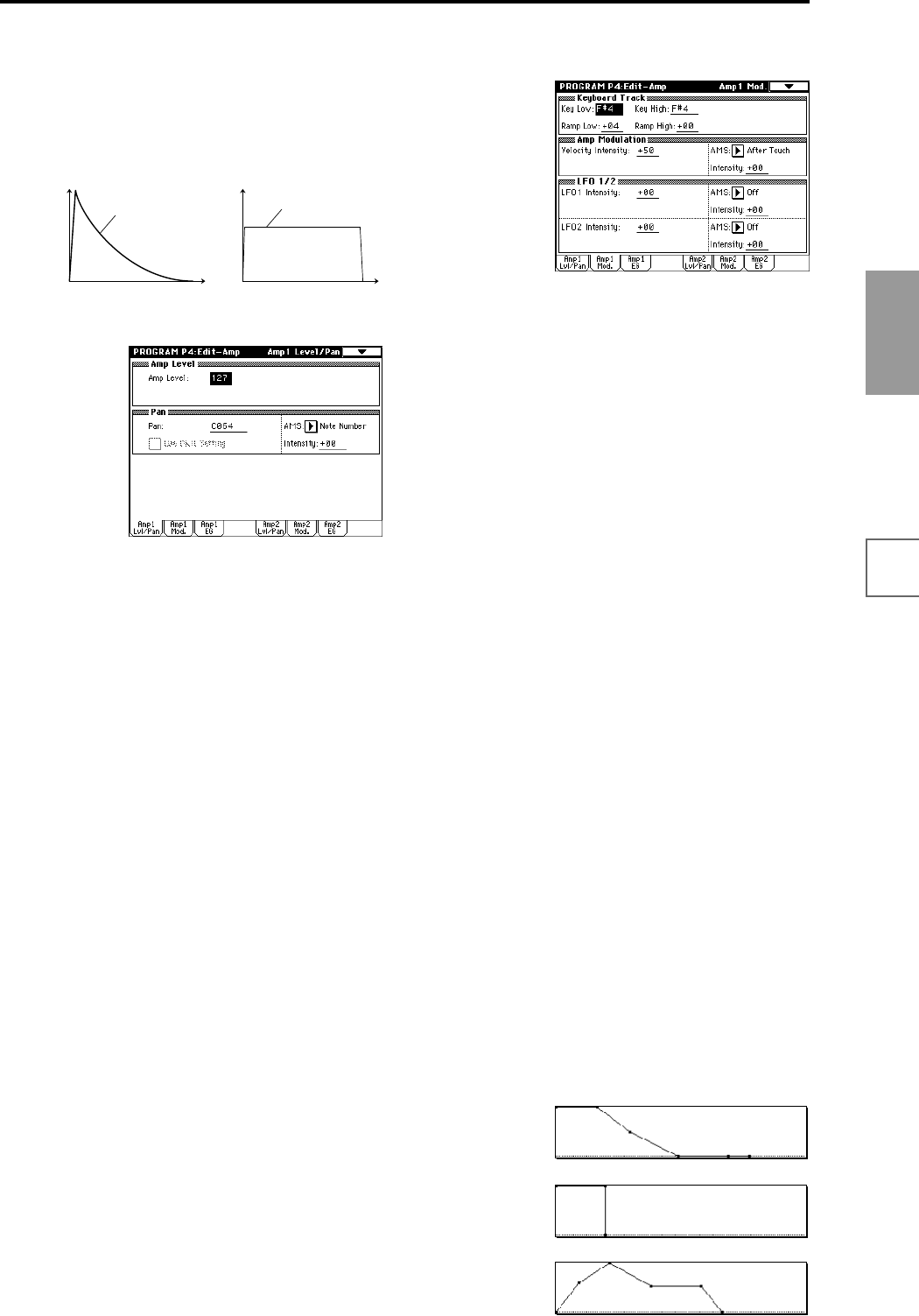
73
Basic functions
Saving dataLoading dataProgram
settings
Combination
settings
Producing
songs
Sampling
settings
Creating a
CD
SMF
playback
System
settings
Drum kit
settings
Arpeggiator
settings
Effects
settings
Other
functions
For example, the volume of a piano note begins at a high
volume the instant you play the note, and then decreases
gradually. The volume of an organ note remains constant
as long as you continue pressing the key. The volume of a
note on a violin or wind instrument can be varied during
the note by the musician (i.e., by regulating the amount of
pressure on the bow or the force of the breath).
Amp1 Level/Pan page
Amp Level
Adjusts the volume of the sound that has passed through
the oscillator, filter, and amp.
Pan
Specifies the pan (stereo position) after the signal has
passed through the oscillator, filter, and amp. Normally
you will set this to C064. If “Oscillator Mode” is Double
and you wish to create a sense of stereo, set the Amp1
Level/Pan page and Amp2 Level/Pan page parameter
“Pan” to left and right for oscillators 1 and 2 respectively.
With a setting of Random, the pan will change randomly
each time you play a note on TRITON STUDIO, produc-
ing an interesting effect.
AMS (Pan AMS), Intensity
“Intensity” specifies the depth of the panning effect that
will occur when “AMS (Pan AMS)” is in use.
If you set “AMS (Pan AMS)” to Note Number, the pan
will change according to the keyboard position at which
you play a note on a TRITON STUDIO. With a setting of
LFO1 or 2, the sound will sweep from side to side (auto
pan). Other settings allow you to move the oscillator pan
by operating a controller.
Use DKit Setting
This is valid when “Oscillator Mode” is set to Drums. If
this is checked, the pan location specified by the Drum Kit
for each drum sound will be used. If this is unchecked, all
drum sounds will sound at the same location. Preload and
GM drum kits are set to stereo settings. Normally you will
leave this checked.
Amp Mod. page
Keyboard Track
This lets you vary the volume relative to the position of
the key you are playing on the keyboard.
• When “Ramp Low” has a positive (+) value, the
volume will increase as you play lower on the
keyboard. With a negative (–) value, the volume will
decrease as you play lower on the keyboard.
• When “Ramp High” has a positive (+) value, the
volume will increase as you play higher on the
keyboard. With a negative (–) value, the volume will
decrease as you play higher on the keyboard.
Amp Modulation
“Velocity Intensity” is used by most programs to decrease
the volume of softly played notes and increase the volume
of strongly played notes, and the Amp Modulation parame-
ter adjusts the depth of this control. Normally you will set
Amp Modulation to positive (+) values. As this setting is
increased, there will be greater volume difference between
softly played and strongly played notes.
LFO1/2
Specifies how the LFO’s will produce cyclic changes in
volume (tremolo effect).
The volume will be affected by the LFO(s) for which you
set an “LFO1 Intensity”, “LFO2 Intensity” value.
“Intensity (AMS Intensity)” adjusts the depth by which
the tremolo effect produced by the LFO will be affected
when you assign an “AMS (LFO1 AMS, LFO2 AMS).”
For example if you set “AMS” to JS-Y: #02, tremolo will
be applied when you move the joystick of TRITON STU-
DIO toward yourself, or when CC#02 is received.
Amp1 EG page
Here you can make settings for the amp EG, which
changes the volume over time.
Every instrument has its own characteristic curve of vol-
ume change. This is part of what gives each instrument its
identifiable character. Conversely, by applying a strings-
type Amp EG curve to an organ-type multisample, you can
produce a sound with a character unlike a typical organ.
Volume
Time
Piano
Volume decays gradually
Volume
Time
Organ
Volume remains constant
until note is released
Piano
Organ
Strings


















